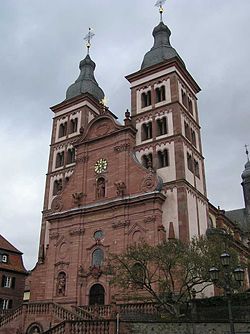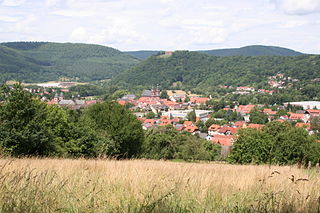
Amorbach is a town in the Miltenberg district in the Regierungsbezirk of Lower Franconia (Unterfranken) in Bavaria, Germany, with some 4,000 inhabitants. It is situated on the small river Mud, in the northeastern part of the Odenwald.
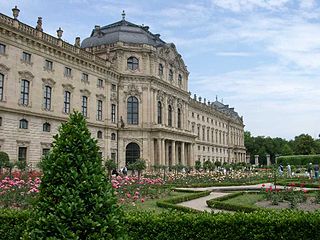
The Würzburg Residence is a palace in Würzburg, Germany. Johann Lukas von Hildebrandt and Maximilian von Welsch, representatives of the Austrian/Southern German Baroque style, were involved in the construction, as well as Robert de Cotte and Germain Boffrand, who were followers of the French style. Balthasar Neumann, court architect of the Bishop of Würzburg, was the principal architect of the Residence, which was commissioned by the Prince-Bishop of Würzburg Johann Philipp Franz von Schönborn and his brother Friedrich Carl von Schönborn in 1720, and completed in 1744. The Venetian painter Giovanni Battista Tiepolo, assisted by his son, Domenico, painted frescoes in the building.

Zwiefalten Abbey is a former Benedictine monastery situated at Zwiefalten near Reutlingen in Baden-Württemberg in Germany. Zwiefalten is on the Upper Swabian Baroque Route.

Saint Emmeram's Abbey was a Benedictine monastery founded around 739 at Regensburg in Bavaria at the grave of the itinerant Frankish bishop Saint Emmeram. The original abbey church is now a parish church named St. Emmeram's Basilica. The other buildings on the site form a large complex known as Schloss Thurn und Taxis or Schloss St. Emmeram, which has served as the main residence of the Thurn und Taxis princely family since the early 19th century.

Neresheim Abbey or the Abbey of Saints Ulrich and Afra, Neresheim is located above the town of Neresheim in Baden-Württemberg, southern Germany. It is now a Benedictine monastery and is part of the Beuronese Congregation.
Münsterschwarzach Abbey, is a monastery for Benedictine monks in Germany. It is located at the confluence of the rivers Schwarzach and Main in Bavaria.

Steingaden Abbey was a Premonstratensian monastery in Steingaden in Bavaria, Germany.
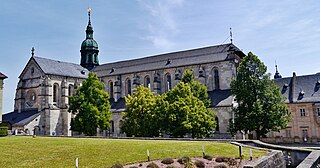
Ebrach Abbey is a former Cistercian monastery in Ebrach in Oberfranken, Bavaria, Germany, now used as a young offenders' institution.

Disentis Abbey is a Benedictine monastery in the Canton of Grisons in eastern Switzerland, around which the present town of Disentis grew up.
Johann Maximilian von Welsch was a German architect, construction director and fortress master builder.

Johannes (Johann) Zick was a German painter of frescoes in southern Germany and active during the Baroque period. He was the father of painter Januarius Zick and considered to be an important master of the Late Baroque.

The title of Prince of Leiningen was created by the Holy Roman Emperor Joseph II, who elevated Carl Friedrich Wilhelm, Count of Leiningen-Dagsburg-Hardenburg to the rank of Reichsfürst on 3 July 1779. Together with all other titles of nobility in Germany, it was abolished with the 1919 Weimar Constitution.

St. Mang's Abbey, Füssen or Füssen Abbey was a Benedictine monastery in Füssen in Bavaria, Germany. It was founded in the 9th century, and dissolved during the post-Napoleonic secularisation of Bavaria.
Ursberg Abbey is a former Premonstratensian monastery, now a convent of the Franciscan St. Joseph's Congregation, situated in the small village of Ursberg in the district of Günzburg, Bavaria.
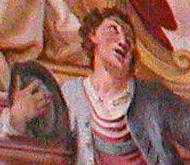
Matthäus Günther was an important German painter and artist of the Baroque and Rococo era.

St. Burchard's Abbey was a Benedictine monastery in Würzburg, Germany, initially known as St. Andrew's Abbey. It was the first abbey established in Würzburg, founded ca. 750. In 1464, it was transformed into a Stift.

Würzburg Cathedral is a Roman Catholic cathedral in Würzburg in Bavaria, Germany, dedicated to Saint Kilian. It is the seat of the Bishop of Würzburg and has served as the burial place for the Prince-Bishops of Würzburg for hundreds of years. With an overall length of 103 metres, it is the fourth largest Romanesque church building in Germany, and a masterpiece of German architecture from the Salian period. Notable later additions include work by Tilman Riemenschneider and Balthasar Neumann. The cathedral was heavily damaged by British bombs in March 1945 but rebuilt post-World War II.

Michaelsberg Abbey or Michelsberg Abbey, also St. Michael's Abbey, Bamberg is a former Benedictine monastery in Bamberg in Bavaria, Germany. After its dissolution in 1803 the buildings were used for the almshouse Vereinigtes Katharinen- und Elisabethen-Spital, which is still there as a retirement home. The former abbey church remains in use as the Michaelskirche.

Neustadt am Main Abbey was an abbey of the Benedictine Order in Neustadt am Main, Bavaria, Germany. It existed from the 8th century until the dissolution of abbeys in the course of secularization in 1803. During its heyday in the early Middle Ages, the abbey was a political power that vied for regional influence with the Prince-bishops of Würzburg, the Archbishops of Mainz and the Counts of Rieneck. Today its location is occupied by a monastery operated by the nuns of the "Dominican Order of Saint Catherine of Siena", also known as Kloster Neustadt. The former abbey church today serves as the Catholic parish church for Neustadt.

Fürstenzell Abbey is a former Cistercian abbey in Fürstenzell, in Bavaria, in the diocese of Passau. It was a daughter monastery of the Aldersbach monastery from the filiation of the Morimond primary abbey - Ebrach monastery.
